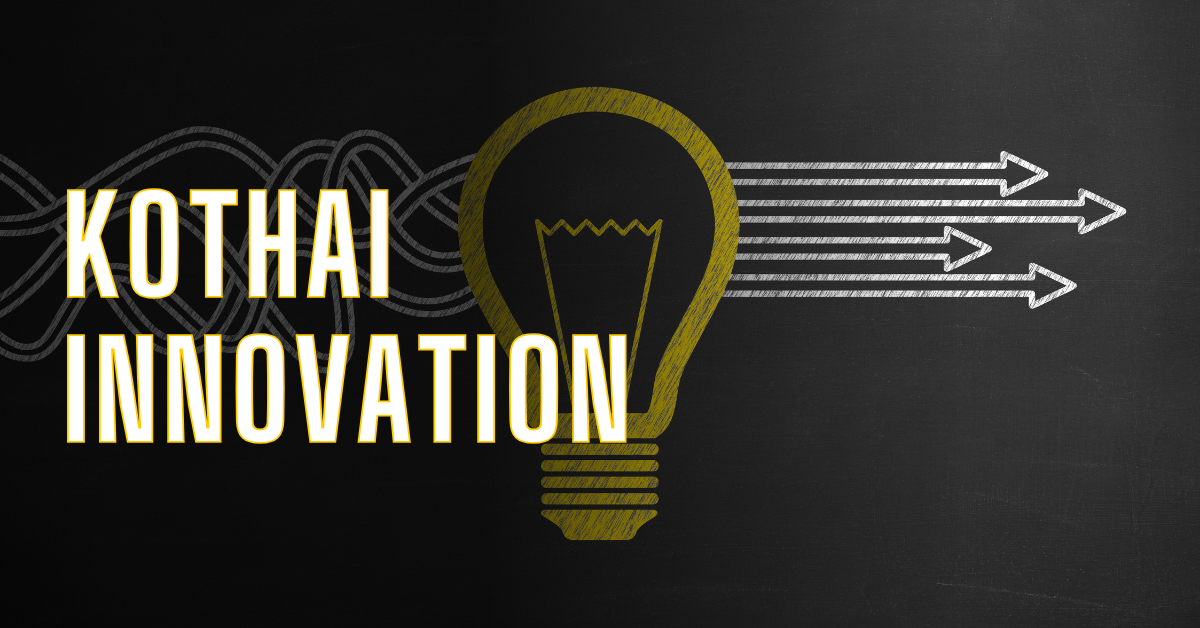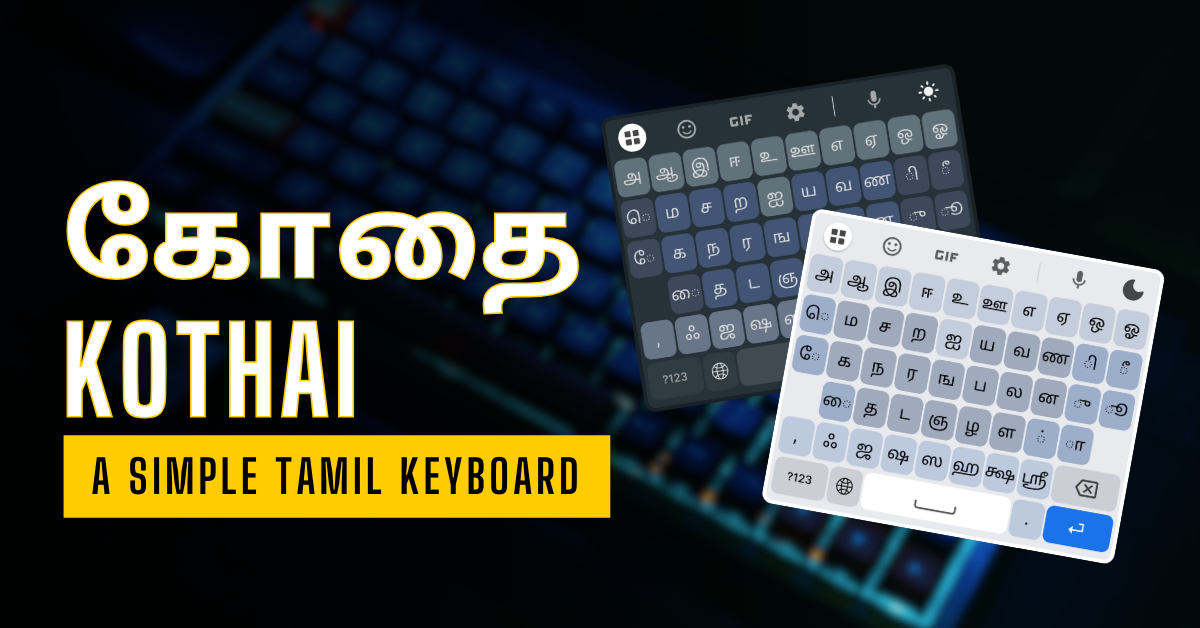Kothai: A Simple Tamil Keyboard & What It Taught Me About Innovation
The Challenge
The printing press was invented by the German Inventor Johannes Gutenberg in the year 1440. This is an invention that changed the world. It became easier for people to spread knowledge. Lots of books were printed in many different languages.
Between 1556 and 1800, 40% of the books that were printed in South Asia were in Tamil. After English, most books were printed in Tamil. Tamil kept pace with technology. Based on this (source: Roja Muthiah Library – The South Asia and Burma Retrospective Bibliography -SABREB), one could also understand the prosperity of Tamil and its people during this period of time. Just for some context, Tamil is one of the oldest languages in the world and we are very proud of its rich heritage.
So, it hurts me when I see people use the English alphabet to write Tamil sentences.
Subramania Bharati’s prediction:
In one of his poems, Subramania Bharati, a great Tamil Poet (1882 – 1921) wrote ‘தமிழ் இனி மெல்ல சாகும்’ (Tamil will have its slow death). More than a prediction, this was his concern for the language. Tamil has been seeing its share of decline in the last 100 years.
In the last 50 years this pace has accelerated. Sadly, we have not done enough. You reap what you sow. Today, you see a lot of adults, kids, and elders prefer to use English to type native Tamil sentences. Tamil is also typed in English with at-least half (I would think) the Tamil speaking population not knowing how to read and write Tamil.
AI & Tamil:
With the advent of AI, we have an opportunity to make amends to our past failures. As Andy Grove calls it, we are at a strategic inflection point. If we do not fix the problem now, it will keep getting worse and it will make it very difficult to reverse the trend (look what’s happening to Intel, for example).
We have a unique opportunity to embrace technology and make sure the language and the population who speak the language are rich and prosperous.
One of the first problems that need to be solved is how to make people use Tamil in Tamil. We need to make Tamil easier to use on devices. We need a simple input method of typing tamil alphabets.
Kothai – A Simple Tamil Keyboard:
Last week, Srija Santhanam launched our new simple Tamil Keyboard Kothai. In her LinkedIn post, she clearly outlines the current problem and how Kothai helps solve it. This is an initiative of DCKAP Palli and we have been chipping at this problem for over 3 years. This is not just an initiative by one person or one company.
It is nice that many people have been researching this problem including people like Elango Cheran (Google), Baskaran Sankaran (Maadhyamik Technologies) and more. Our Kothai app is now live. You can download the Kothai app on your android devices now. We are also working on an iOS version.
As Srija outlines in her post, this is not just an issue unique to Tamil. It is a common challenge for many (if not all) Indian Languages including Hindi, Malayalam, Kannada, Telugu, Marathi, Gujarati and more. Transliteration (in this case, typing in English letters) has become the default way we communicate digitally.
Tamil is important not just within India. The language is spoken by communities in countries like Sri Lanka, Singapore, Malaysia, Myanmar, and we have Tamil speaking communities across the world. It is important that the Tamil communities across the world and in Tamil Nadu learn to read and write the language and also use it digitally.
How does the Kothai Tamil keyboard solve this problem?
Kothai introduces a handwriting-style Tamil typing method which mirrors the Tamil handwriting style.
This will also help you read and write Tamil better and help with your Tamil learning. It also simplifies Tamil typing by reducing the number of key selections. Instead of choosing from dynamically changing characters (e.g., selecting “க” and then modifying it to get “கோ”), Kothai allows users to type in sequence, just like writing on paper.
For example, to type “கோ” on most keyboards, users have to select “க” and choose variations like “கா, கி, கீ, கு, கூ, etc.” In Kothai, users type sequentially: “ே” + “க” + “ா” – mimicking the natural handwriting process.
This is just one of the many initiatives we are working on. One thing we would like to do is to make it profitable to invest in Tamil. When there is money to be made, more people will start to read, write and learn the language.
How to Innovate: What Kothai’s Story Taught Me
I have been asking myself this question—how to innovate? I am not an expert in this area. However, one does not have to be an expert to share their experiences. This hustle is based on my personal journey over the last few years.
Why?
It starts with why. Why do you want to innovate? What problem are you solving?
One of the big problems that frustrated me was the increasing use of English alphabets to write native Indian language scripts. I deeply care about this—I hate it when people use English alphabets to type Tamil. However, this issue extends beyond just one language; it affects almost all Indian languages.
People:
Once you identify a problem, you need people to brainstorm ideas and execute them. Sometimes, your core team may not be able to help with this—they are busy solving customer problems that generate revenue today or working on the future release of their product. In such cases, you need buy-in from internal team members who passionately believe in the problem you are trying to solve.
We knew what the problem was, but we weren’t sure how to solve it. So, we decided to take the intern route.
Experiment:
Experimentation is a key component of innovation. You will face failures—not everything will go as planned. The intern we hired pre-Covid worked with us for three months and did a fairly good job. We were not sure where to start. He focused on converting voice-to-text in Tamil, created some models, and demonstrated a small working prototype.
Later, he discovered Google Web Speech API, which essentially did the same thing we were trying to build. Our Voice-to-Text problem for Tamil didn’t seem like a problem anymore. The intern had other priorities and moved on. However, one major outcome of this experiment was learning about Google’s Web Speech API, which I still use today.
Re:Search:
We tried to hire people full-time but didn’t have much luck. The problem was put on hold for a year or two. In hindsight, we should have continued even more aggressively. We restarted our search and looked at other use cases to work on.
Keep Talking About the Problem:
I find that constantly talking about the problem has huge benefits. Whenever I had an opportunity, I kept bringing up the issue of using English alphabets to type in Tamil.
In 2021, we started DCKAP Palli. We had about 20 students in our first batch, and I visited them often. I kept discussing the problem.
“Recognizing this as a challenge, the first batch of DCKAP Palli students took up the problem, conducted extensive research on Tamil input methods, and worked to design a keyboard layout that makes Tamil typing easier.” recounts Srija.
And so, we truly got started on building a decided to build a simple, easy-to-use keyboard for Tamil. As Sunil Mithran T K, Social & Community Development Specialist at DCKAP puts it, “It all started with asking more ‘whys’ — questioning the conventional methods helped us shape the keyboard exactly how we envisioned it. More importantly, it gave the students a first-hand experience with the process of innovating — perhaps the first of many to come.”
It was a great way to have innovation come from within, while also giving a very practical opportunity for the students to get hands-on with what they have been learning.
I’m glad to hear that it was a great experience for them as well. Dhanush Govindan, a student from the DCKAP Palli batch said, “I truly enjoyed the process of working. I gained valuable experience and new insights that helped me grow. I especially enjoyed researching global solutions and using that knowledge to make ours unique. It was a fun and insightful journey!”
Get External Help:
The students did an amazing job, and the prototype they built was a success. We wanted to take this to the next level, but we ran into a challenge. Once the coursework and internship were over, the students wanted to focus on revenue-generating products and weren’t keen on dedicating full-time effort to this.
That’s when we decided to get external help—to leverage what the students built and refine it into a polished product.
Pranavan N., CEO of NextGen Innovations shared about his experience working on Kothai saying, “Working on the Kothai app gave us a glimpse into how writing has shaped our knowledge over time. As typing styles evolved, we learned to bridge the past and present through innovative solutions. Proud to be part of this initiative for தமிழ் (Tamil)! I used to type in Tanglish too, but now I believe it’s time to embrace and switch to pure தமிழ்.”
He added, “As a software partner, our collaboration with the Kothai Keyboard app has been a rewarding experience, enabling us to contribute to the preservation and promotion of தமிழ் through innovative technology. We are proud to support this initiative and empower users to embrace pure தமிழ் typing.”
Learnings:
I believe what we have done here is an invention. This is the first-of-its-kind Tamil keyboard, where you key in characters exactly as you would write them on paper. Inventions don’t have to be just combustion engines, cars, or iPhones. Even small innovations like this, which solve local problems, are inventions.
It has been incredibly motivating to work on this. Along the way, we took a break for a couple of years, which, in hindsight, could have been avoided. You need to keep working on the problem and iterating continuously.
Cash is important. Running experiments costs money. Getting external help was a game-changer—it helped us move fast.
This is how Kothai, our simple and intuitive Tamil keyboard, was created. Now, we need to figure out how to take it to market and change the way people write Tamil today.
If you haven’t tried it yet, you can download Kothai from the Google Play Store.
Thank you for reading.
Karthik Chidambaram


Leave a Reply